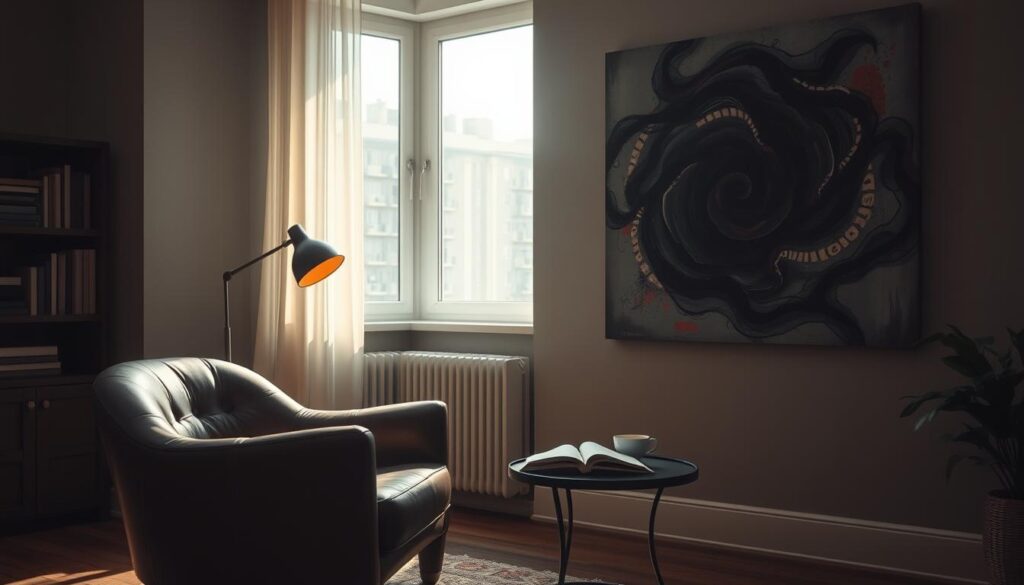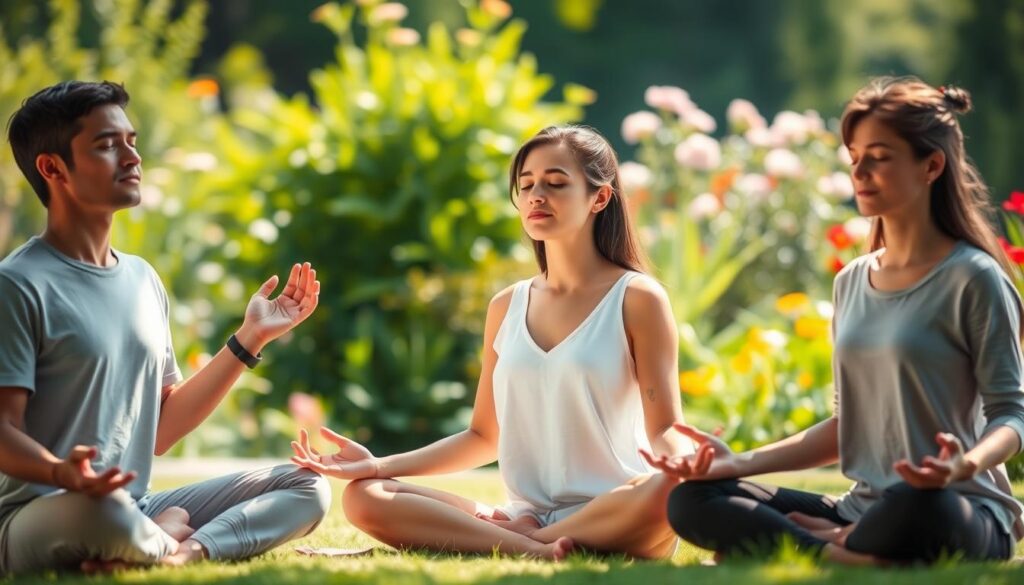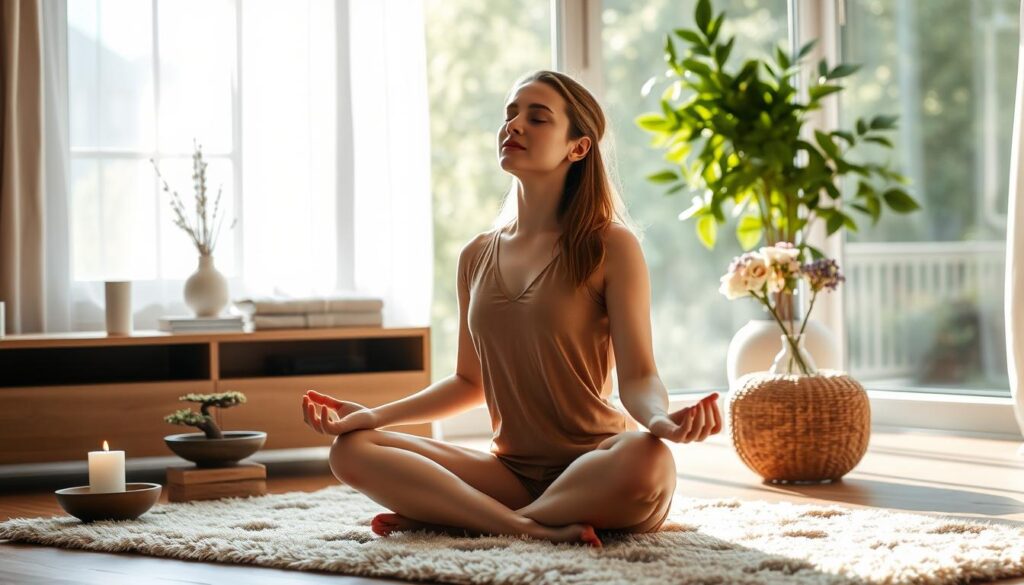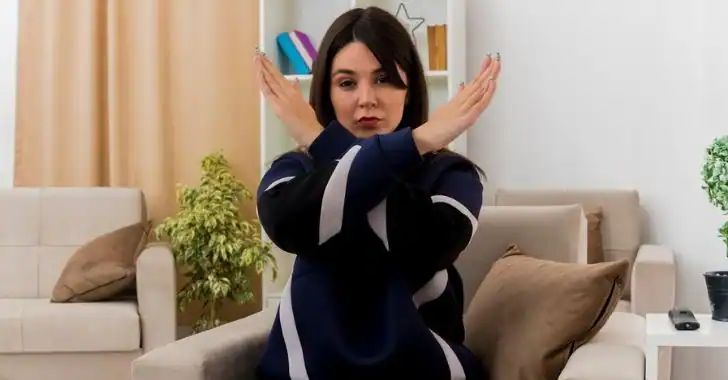Managing anxiety can be tough. Mindfulness practices are a great way to reduce anxiety and improve your mental wellness.

Understanding Anxiety and Its Effects
Anxiety is a complex condition that can affect many parts of your life. Its important to know the difference between normal stress and anxiety that can overwhelm you. While feeling anxious in some situations is commoon disorders like generalized anxiety disorder GAD or panic disorder need more care.
What is Anxiety?
Anxiety is marked by constant worry and fear. Its more than just feeling a little scared. It can disrupt your daily life. People with anxiety often get stuck in a cycle of fear and worry. This can hurt their relationships and work performance.
The Physical and Mental Symptoms of Anxiety
Anxiety can show up in different ways physically.
You might notice:
- Increased heart rate
- Sweating
- Muscle tension
These signs are your body’s stress response. Mental symptoms
- Constant worry
- Difficulty concentrating
- Restlessness

Knowing these symptoms is key to understanding and managing anxiety. Recognizing how physical and mental symptoms work together can help find better ways to cope.
The Role of Mindfulness in Mental Wellness
Mindfulness and mental wellness are closely linked. Mindfulness can greatly help with anxiety. It works by making you more aware of your thoughts and feelings in the moment.
How Mindfulness Works to Alleviate Anxiety
Mindfulness helps you focus on the present, not just your thoughts. It makes you aware of your feelings, helping you not let anxiety control you. Studies show it can even change your brain, making you more resilient to stress.
This change can lead to better emotional stability. You’ll feel more grounded and able to handle life’s ups and downs.
The Benefits of Mindfulness for Stress Management
Mindfulness does more than just reduce anxiety. It boosts your mental health in many ways. It improves focus, emotional strength, and self-understanding.
As you get better at noticing your thoughts and feeling managing stress becomes easier. Mindfulness bring calm and clarity. It helps you stay present reducing the feeling of being overwhelmeed.

Top Mindfulness Practices to Reduce Anxiety
Adding mindfulness to your daily life can really help with anxiety. Breathing exercises and guided meditation are two great ways to start. They help you connecct with yourself and find calm.
Breathing Exercises to Calm Your Mind
Breathing exercises are easy but very effective. Try the 4 7 8 method breathe in for four seconds hold for seven and breathe out for eight. This can slow your heart rate lower stress and make you feel relaxed.
Doing these exercises often can make you feel clearer and more emotionally stable.
Guided Meditation for Beginners
Guided meditation is perfect for beginners. Its led by experts who guide you through peaceful techniques. You can find lots of guided meditations online in apps and on websites.
These sessions help you relax deeply and focus your mind. They’re a great way to add to your mindfulness routine.

Incorporating Mindfulness into Your Daily Routine
Adding mindfulness to your daily life can boost your mental health. Daily mindfulness routines help create a balanced and fulfilling day. Focus on your mornings and evenings for positive experiences and relaxation.
Mindful Mornings: Starting Your Day Right
Your mornings are a fresh start perfect for mindfulness.
Start your day with these activities:
- Gratitude journaling: Write down what you’re thankful for. It changes your mindset and outlook.
- Mindful stretching: Do gentle stretches while focusing on your breath. It warms your body and calms your thoughts.
- Mindful meditation: A short meditation session clears your mind and prepares you for the day.
Evening Mental Wind Down Practices
Ending your busy day with peace is key for wellness. Evening practices help you relax and recharge. Try these:
- Reflective journaling: Write about your day including the good and bad.
- Gentle breathing exercises: Focus on deep rhythmic breathing to relax.
- Aromatherapy: Use calming scents like lavender or chamomile to create a peaceful sleep environment.

Techniques for Anxiety Relief
Exploring mindfulness techniques can be a valuable addition to your toolbox for managing anxiety. These anxiety relief techniques focus on bringing your attention to the present moment. They help create a sense of calm amidst chaos.
One effective method is body scanning. This technique involves focusing your attention on different parts of your body. You acknowledge any sensations tension or discomfort. By promoting physical awarenes you can foster relaxation and reduce anxiety.
Mindful walking is another technique. It encourages you to be aware of each step and the movements of your body. This practice can shift your focus from anxious thoughts to the rhythm of your movement.
Incorporating short meditation sessions into your day can also provide respite. Even dedicating five to ten minutes to mindful breathing can serve as one of the most useful coping strategies for anxiety. The act of observing your breath helps to center your thoughts, allowing you to remain grounded in the moment.
These mindfulness techniques not only help with immediate anxiety relief. They also contribute to building longterm resilience against stress. Including a variety of practices in your routine will empower you to handle any anxiety-provoking situations more effectively.

Combining Mindfulness with Cognitive Behavioral Therapy for Anxiety
Using mindfulness with cognitive behavioral therapy for anxiety is a strong strategy. Cognitive behavioral therapy helps you change negative thoughts that lead to anxiety. Adding mindfulness lets you notice and handle anxiety triggers better. This mix helps you understand your feelings and find better ways to cope.
Understanding CBT and Its Benefits
Cognitive behavioral therapy is known for helping with anxiety. It teaches you to look at your thoughts feelings and actions. This way you learn to face and change bad beliefs. Studies show it cuts down anxiety symptom making you feel better overall.
Integrating Mindfulness into CBT Techniques
Mindfulness in CBT means being fully present and not judging your thoughts. Adding mindfulness to CBT makes it even more effective.
Here are some ways to do it:
- Breathe: Focus on your breathing during sessions to ground yourself.
- Mindful Reflection: After identifying negative thought patterns, take a moment to reflect mindfully on these thoughts.
- Visualization: Use mindfulness to visualize positive outcomes as you challenge irrational beliefs.
This mix not only manages anxiety but also helps with emotional control. By using mindfulness in CBT you get tools to deal with anxiety better.

Natural Remedies for Anxiety Through Mindfulness
Managing anxiety can be easier with natural remedies and mindfulness. Essential oils and herbal teas are great for relaxation and stress relief. They are known for their calming effects.
Essential Oils and Aromatherapy
Essential oils are great for anxiety. Lavender and chamomile oils are known for their soothing effects. You can use them in a diffuser or add a few drops to a warm bath.
Inhaling these oils can make you feel calm. It helps you focus on the present moment.
Herbal Teas that Promote Relaxation
Herbal teas are also good for anxiety. Chamomile – valerian root – and lemon balm teas are popular. Drinking these teas can make you feel calm.
They help you relax and enjoy the moment. Over time they can make you feel more peaceful.
Relaxation Techniques for Anxiety Management
Looking for ways to manage anxiety? Relaxation techniques like Progressive Muscle Relaxation (PMR) and visualization can help a lot. They calm your mind and help your body relax, which is key to feeling better.
Progressive Muscle Relaxation Explained
Progressive Muscle Relaxation is about tensing and relaxing your muscles one by one. It helps you notice where you hold tension. Doing this regularly can make you feel more relaxed and less anxious over time.
Visualization Techniques to Ease Tension
Visualization takes you to peaceful places in your mind. Imagine a calm beach or forest to ease anxiety. Its a way to relax your body and mind helping you break the stress cycle.
Self-Help Tips for Practicing
Practicing mindfulness can be easier with some helpful tips. Use a mindfulness journal and set realistic goals. These steps help you understand anxiety better and build resilience every day.
Creating a Mindfulness Journal
Begin by keeping a mindfulness journal. Its a personal space to write about your feelings and experiences. By jotting down your thoughts, you can spot patterns in your anxiety and what triggers it. Regular writing boosts self awareness and shows your progress.
Setting Realistic Goals
When setting mindfulness goals, aim for what realistic. Choose goals that match your life, like a daily meditation or gratitude practice. Achievable goals help you stay consistent. As you meet your goals you will feel clearer and less anxious.
Conclusion
As we wrap up our look at mindfulness its clear these practices can really help with anxiety. They also boost your mental health. By adding mindfulness to your day, you can find peace and balance.
Practices like breathing exercises and meditation can make life tough spots easier. Mindfulness does more than just ease anxiety. It builds resilience and self-awareness, helping you stay grounded.
Start using these mindfulness techniques on your path to better mental health. With regular practice, you’ll fight anxiety and find true well-being.



